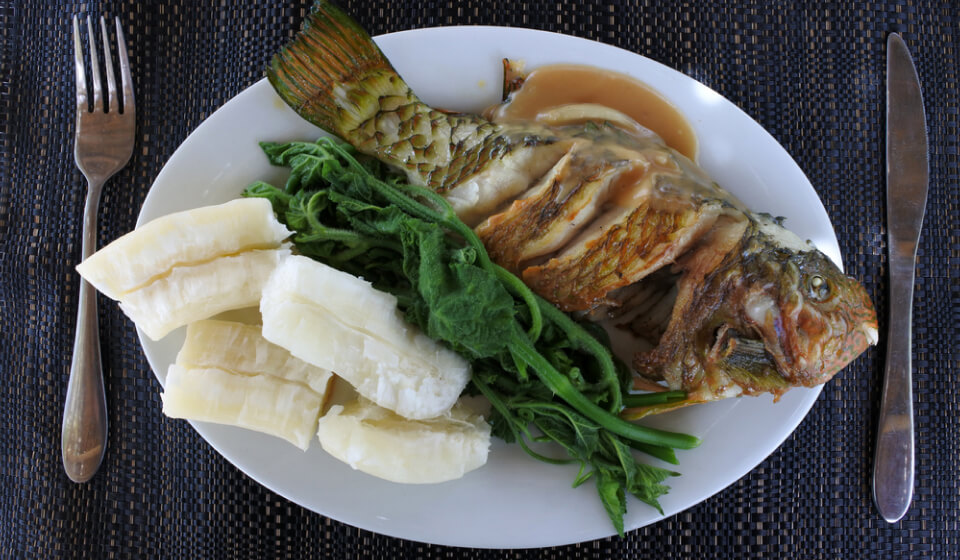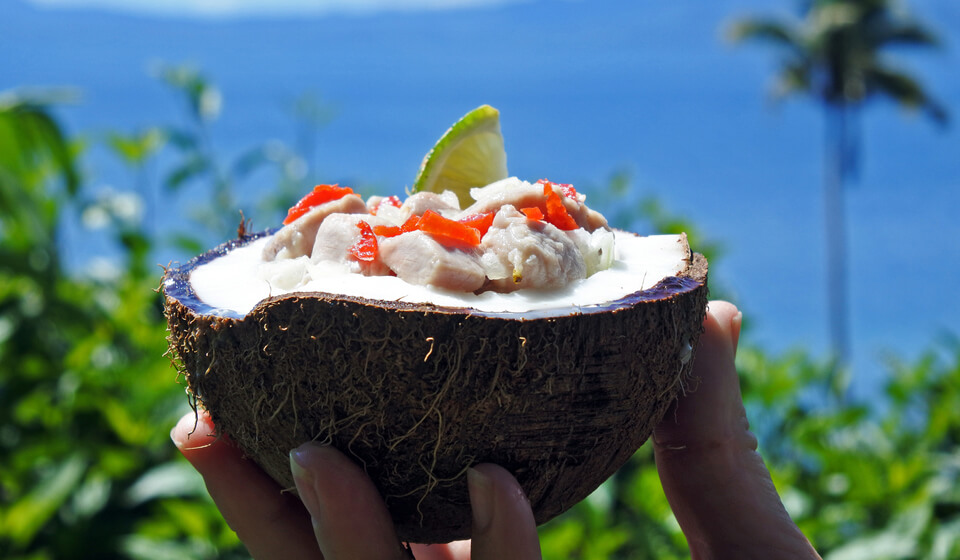Fiji is a tropical paradise renowned for its pristine beaches and warm hospitality, offering a culinary adventure as diverse and vibrant as its culture. From the traditional dishes influenced by indigenous Fijian, Indian and European flavours to unique local delicacies, there is something to tantalise every taste bud. Join us on a foodie journey through Fiji’s must-try local cuisines.
Traditional Fijian Delights
- Lovo
The quintessential Fijian festa lovo is a traditional underground oven that cooks food using hot stones and leaves. Various meats, vegetables and root crops are wrapped in banana leaves and buried in the lovo for several hours, resulting in a succulent and smoky flavour. - Kokoda
It is a refreshing and tangy appetiser. Kokoda is made using raw fish marinated in lime juice, coconut milk and spices. The fish is often served with onions, tomatoes and chilli peppers for a spicy kick. - Palusami
A hearty vegetable dish made using taro leaves, coconut milk and onions. Palusami is often served as a side dish wrapped in banana leaves and cooked in a lovo. - Rourou
A leafy green vegetable similar to spinach, Rourou is often cooked with coconut milk and spices. It can be enjoyed as a side dish or added to soups and stews. - Dalo
A starchy root vegetable Dalo is a staple food in Fijian cuisine. It can be boiled, roasted or fried and is often served with fish and meat dishes.

Indian Influences
Fiji’s Indian heritage is evident in its vibrant and flavourful cuisine. Here are a few must-try Indian dishes:
- Curry
It is a staple in Fijian dishes and is made with various spices, vegetables, and meat or seafood. Curries can be mild, medium, or spicy depending on your preference. - Roti
A flatbread made from wheat flour, roti is a versatile accompaniment to curries, stews and other vegetables. It can be served plain or stuffed with vegetables or meat. - Palusami
A hearty vegetable dish made using taro leaves, coconut milk and onions. Palusami is often served as a side dish wrapped in banana leaves and cooked in a lovo. - Samosa
A deep-fried pastry filled with spiced potatoes and peas. Samosas are a popular snack or an appetiser.

European Influences
Fiji’s colonial history has left its mark on its cuisine, with European influences evident in many dishes. Here are a few examples:
- Fish and Chips
A classic British dish, fish and chips, is popular in Fiji, especially in tourist areas. Freshly caught fish is battered and fried, then served with french fries and tartar sauce. - Steak and Fries
A hearty and satisfying meal, steak and fries are a popular choice for dinner. The steak is often grilled or pan-fried and served with french fries and a choice of sauce. - Pizza
A beloved Italian dish, pizza is available in many variations in Fiji. From classic Margherita to Hawaiian, there is a pizza that suits every taste.
Unique Local Flavours
In addition to traditional and influenced cuisines, Fiji offers some unique local flavours that are worth exploring:
- Kava
A traditional Fijian drink from the roots of the Kava plant. Kava has a slightly bitter and earthy taste and is often served at ceremonial gatherings. - Bula Cakes
These moist and flavorful cakes are a popular treat in Fiji. They come in various flavours, including vanilla, chocolate and coconut. - Yaqona
A refreshing drink made from the roots of the yaqona plant. Yaqona is slightly bitter and earthy and is often served in ceremonial gatherings. - Kokosnuss Eis
This creamy coconut ice cream is a popular dessert in Fiji. It is the perfect way to cool down on a hot day.
Whether you are a seasoned foodie or simply looking to try something new, Fiji’s diverse cuisine has something to offer everyone. From traditional Fijian dishes to Indian and European influences, a flavour explosion is waiting to be discovered. So pack your bags and prepare to embark on a culinary adventure in this tropical paradise.
Beyond the Basics: Exploring Fijian Cuisine
While the dishes mentioned above are a great starting point, Fiji’s culinary landscape has much more to discover. Let’s delve deeper into some of Fijian cuisine’s unique and lesser-known aspects.
Regional Variations
Fiji’s diverse geography and history have led to regional variations in its cuisine. For instance, the islands of Vanua Levu and Taveuni are known for their fertile soil, which produces abundant fruits and vegetables that influence their local dishes. On the other hand, the islands of Lau, with their proximity to the ocean, strongly emphasise seafood.
Street Food Scene
Fiji’s street food scene is a must-try for adventurous foodies. From lovo served from roadside stalls to kokoda sold from colourful vans, there is a wide variety of delicious and affordable options.
Fijian Beverages
In addition to Kava and Yaqona, Fiji offers a variety of other refreshing beverages. Bula water, a sparkling water infused with tropical flavours, is a popular choice. Coconut water is a natural thirst quencher, while yaqona is often enjoyed in ceremonial settings.
Sustainable and Ethical Dining
Fiji is committed to sustainable and ethical dining practices. Many restaurants source their ingredients locally and prioritise organic and fair trade products. Look for restaurants that support local farmers and fishermen.
Conclusion
Fiji’s cuisine reflects its rich cultural heritage and diverse influences. From traditional Fijian dishes to fusion cuisine and street food, there is something to satisfy every palate. By exploring the local markets, trying new dishes and learning about Fijian culinary traditions, you can truly experience this tropical paradise’s vibrant and flavourful side.





